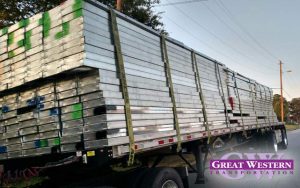Flatbed trailers are used to transport a variety of cargo like building materials and heavy equipment. They offer a great deal of convenience in loading and unloading these large, often unruly items. Flatbed trucking companies must follow strict federal regulations regarding the proper securement of this type of cargo. These regulations stipulate the types of securement devices to be used, the number of devices required and their proper placement.
Types of Securement Devices
The cargo securement is accomplished by using tiedowns that attach to the body of the trailer, thus preventing the cargo from shifting during transport. Steel strapping, chains, synthetic webbing, wire ropes, cordage, chocks and wedges are all types of securement devices that are commonly used in flatbed transportation. The type of device used depends upon the weight of the cargo and the load limits of the devices. In some cases, multiple types of devices are used to assure the load is adequately secured, for example, synthetic webbing, chains and chocks would be used to hold a piece of heavy equipment on a trailer.
Number of Devices Required
Determining the number of securement devices you must use on a particular load requires two figures; the length of the cargo and its weight. Federal laws require one tiedown for every ten feet of cargo, and any fraction of that measurement requires an additional device. For example, a load that is 22 feet long would require three tie downs if it’s placed against a header board and an additional device if it’s in the center of the trailer. The total working load limit of the devices must be 50% of the total weight of the cargo. Keep in mind these are the minimum requirements, additional devices may be necessary for particularly bulky, or oddly shaped cargo.
Proper Device Placement
The final component of properly securing a load is the placement of the device on the load and attaching it to the trailer. Trailers are equipped with tiedowns that straps, chains and other devices connect to. The device attaches to the cargo and the vehicle, passed through the cargo and attached to the vehicle, or simply attached to the cargo. It is vitally important that these devices are evenly spaced across the load to prevent the load from moving. Chocks and wedges are placed under the wheels to prevent cargo from rolling, or otherwise shifting.
In addition to choosing the proper type, number and placement of devices, drivers must be diligent in their efforts to assure that the devices they use are not damaged or otherwise compromised. During transit, it is imperative that the driver inspects each device to assure it’s tightened down and connected properly. By following the federal regulations for load securement, flatbed carriers and their drivers assure that cargo travels safely to its destination and always arrives in good condition.





